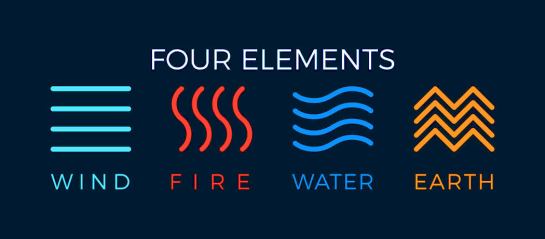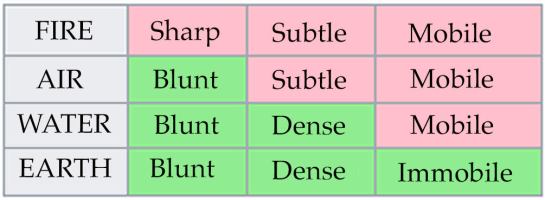.
by Richard Nilsen
.
I am always amazed at how smart the ancients were. We tend to think of them as primitive, compared to our modern knowledge. But over and over, they turn out to have been on to things we are only now catching up with.
.
Of course, they didn’t have the apparatus for testing chemicals or physics, but considering their guesswork, they were often prescient.
.
As far back as the 5th Century BCE, Leucippus and Democritus inferred that matter was created out of atoms (from the Greek word “ἄτομον,” meaning “uncuttable”). They figured that if you could break apart a clump of dirt into smaller clumps, eventually you would get to a clump so small that it could no longer be subdivided. That would be the basic substance of creation. They didn’t have the experimental means to prove it, but then, neither did modern science until Einstein’s work on Brownian Motion in 1905. Although atomic theory was widely accepted in chemistry, proof of it is only a little over a century old.
.
But the Greeks weren’t alone. In the 6th or 7th Centuries CE, several Indian thinkers also came up with the idea, called “kalapas,” or “bundles,” which were the indivisible chunks of reality. These smallest units of physical matter were said to be about 1/46,656th the size of a particle of dust from a wheel of chariot.
.
Further, such thinkers as Dharmakirti actually anticipated quantum mechanics in his belief that such atoms were only local manifestations of motion or energy, and could pop into and out of existence quite randomly. I.e. — Sailing on the Dirac Sea.
.
Most of what we find in the way of science in ancient cultures is astronomy and mathematics — and that primarily geometry. The ancient Mesopotamians calculated the length of the solar year quite accurately (so much so, that we still base our months, weeks, and days on their systems).
.
The data collected by these Mesopotamian astronomers led the Greek mathematician Hipparchus to calculate the precession of seasons. Hipparchus (ca. 190 BCE-ca. 120 BCE), often called the father of astronomy, calculated many amazing things, including the distance and size of the moon.
.
Among the other findings of Ancient Greek thinkers, both Classical and Hellenic, you find:
.
Eratosthenes (ca. 275 BCE-ca. 195 BCE) accurately measured the circumference of the earth and the tilt of the earth’s axis.
.
Aristarchus of Samos (ca. 310 BCE-ca. 230 BCE) hypothesized that the sun was the center of the solar system and the earth revolved around it.
.
Hippocrates (ca. 460 BCE-ca. 270 BCE) recognized that illness was not visited on people by the anger of the gods, but had organic causes.
.
But what I am interested is not merely the advances in science and medicine by individual Greeks, but in the pervasiveness of certain aspects of ancient Greek science that persisted into the modern era, and how we have come to disprove some of those theories, only to later come to see in them some surprising glimmers of truth.
.

.
One of the longest lasting ideas in ancient science was the belief in the four elements: earth, air, water, and fire. It began with pre-Socratic philosophers in the seventh century BCE and continued through the Middle Ages, with vestiges hanging on into the early modern era.
.
These early thinkers argued over whether the primordial substance of matter was perhaps water, perhaps air. Thales (ca. 626/623-ca. 548/545 BCE) believed that water was this principle. Anaximenes (ca. 586-ca. 526 BCE) favored air, and Heraclitus (fl. ca. 500 BCE) claimed it was fire. Anaximander (ca. 610 – ca. 546 BCE) argued that the primordial substance was not any of the known substances, but could be transformed into them, and they into each other.
.
It was Empedocles (ca. 450 BCE) who first numbered the elements at four. He called them the “roots” of existence. It was his schema that took hold and became codified by Aristotle and it was the primacy of Aristotle during the later classical and Medieval ages that cemented them in place.
.
“An element, we take it, is a body into which other bodies may be analyzed, present in them potentially or in actuality (which of these, is still disputable), and not itself divisible into bodies different in form. That, or something like it, is what all men in every case mean by element,” wrote Aristotle in On the Heavens.
.
It is hard to overestimate the authority Aristotle held for European (and later Islamic) civilization before the Enlightenment.
.
In On Generation and Corruption, he said that the qualities of each could describe all of matter. Fire, he said, was both hot and dry; air was both hot and wet (thinking particularly of vapor); water, he said, was both cold and wet; while earth was both cold and dry.
.
If we go back to the early atomist thinkers, most held that these atomic particles must exist in a medium other than themselves, and so posited that the cosmos consisted of atoms, on one hand, and a “void,” or emptiness on the other. Otherwise, as the Latin poet Lucretius said, motion would be impossible because they atoms would need some space to move into. Others called this interstitial emptiness the “aether.”
.
Aristotle accepted the idea, although not the name. The name, however persisted, even to today.
.
The Neoplatonist Proclus defined the four elements with other properties:
.

.
It should be noted that other cultural traditions also split up the cosmos into these five things. In the Vedas of India, the “Five Great Elements” are bhumi, or earth, apas, or water; agni, or fire; vayu or wind (air) and akasa, or void (or space).
.
Tibetan Buddhism have the same five elements. In Pali literature the four elements (mahabhuta, or “great elements), are identified with solidity (earth); fluidity (water); temperature (fire); and mobility (air). In another tradition, these four great elements are amplified with a secondary group of color, smell, taste and nutriment, all of which derive from the primary four.
.
In the baKongo religion of central Africa, the physical world is made of water (identified with the south); fire (the east); air (the north); earth (the west), and mBungi, the circular void that begot the universe.
.
In Japan the godai (the “five great”) are earth (rocks and stability); water (fluidity and adaptability); fire (life and energy); wind (movement and expansion); and the Void (spirit and creative energy).
.
The Islamic philosopher, including Avicenna, followed Aristotle, but also divided the four elements into the active forces (heat and cold); and the recipients (dryness and moisture).
.
The Medicine Wheel in many indigenous American cultures is almost always divided into four quarters, which are the four cardinal directions; the four seasons; the four ages of man; and the four elements: earth; fire; wind; and water.
.
This division of matter is almost universal across cultures and seems a natural way of sorting out the material world.
.
The four elements also used to build early medical theories. The four elements were akin to the four humors: blood (air — although why is difficult to explain now); phlegm (water); yellow bile (fire); and black bile (earth). Galen believed that illness was due to an imbalance of these humors.
.
“Humor” is a translation of the Greek word χυμός, or “chymos” which literally means juice or sap. Each humor was associated with a temperament, or personality type. Someone was “phlegmatic” when they were slow to act, were lazy, or slow of wit; To be “choleric” was to be ruled by yellow bile, which made you ambitious, aggressive, short tempered; the sanguine personality (ruled by blood) was enthusiastic, active and social; and black bile (literally melancholy) was a depressive.
.
In the Medieval mind, which was systematic if nothing else, these all lined up very well.
.

.
I bring all this up, not just because it is interesting, or because more than 2000 years of western culture relied on them so that they show up in art and literature, but because after a century of disproving them, we have again come back to them, albeit in a quite modified form.
.
Take the four elements, which are no longer elements, but are the four states of matter: solid, liquid, vapor, and plasma. And the four humors are now dopamine, norepinephrine, serotonin, acetylcholine and a host of other neurotransmitters, hormones, and pheromones. We have fancier names for them now, but the basic idea of the humors has come back to medicine.
.
Isaac Newton believed that gravity, as a force, had to be carried by something, which he called the aether. Later, scientists thought that light needed a medium to travel through and used the term aether.
.
In his two theories of relativity, Einstein proved that such a medium was not needed, but did have to add a “cosmological constant” to his equations to make them work out. That constant — later proved unnecessary — he called “the greatest blunder of my life.”
.
And yet, quantum scientists have now given us the idea of the quantum vacuum state, which is very like the void of the ancients. And it raises the possibility that dark energy might be a new version of the aether.
.
After all this, my primary point is that the ancient philosophers and natural scientists and medical practitioners were not simply dumb bunnies who didn’t really understand how things really are, but rather amazingly intelligent thinkers who managed amazing insights without the aid of microscopes, telescopes, litmus papers, titration devices, voltometers, geiger counters — or any of the whole storage bin of hardware we have incrementally devised since the 17th century. Newton said we stand on the shoulders of giants, and these ancient thinkers were the strongmen at the base holding up the human pyramid on which we stand as the current pinnacle.
.
Richard Nilsen inspired many ideas and memories at the salons he presented through the years when he was an arts critic and movie, travel, and features writer at The Arizona Republic. A few years ago, Richard moved to North Carolina. We want to continue our connection with Richard and have asked him to be a regular contributor to the Spirit of the Senses Journal. We asked Richard to write short essays that were inspired by the salons.
